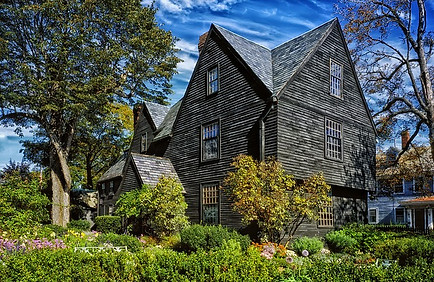

Salem, MA
by John Zaffis
If you have the opportunity to visit Salem, Massachusetts and you are a ghost hunter this is "the place". The cemeteries, old historical homes and alot of other sites are a ghost hunters paradise, you are almost guaranteed to get something on film. Most of this information is documented and in books about the Salem haunting's . Many of the homes in and around the Salem area are also haunted.
We stayed in two homes that are 200 plus years old and let me tell you we experienced the ghosts in these two homes and definitely heard the noises. But what I find funny about this is, I don't think the families would have believed we did not experience anything in the homes. We have had the opportunity to go into several of these buildings to do investigations for a local cable company and document the haunting's fortunately for us I was able to capture some of the ghosts on film and the photos are on the website.

I know one thing for sure in Salem there is a lot of recognition given to the supernatural realm so this makes it an interesting place to investigate. I hope you have the opportunity to do so. Now I would like to go into some of the history of Salem and its witch trials, which led to what is called today "Salem one of New England's most haunted areas". In 1692 a small girl fell sick with fits and convulsions and outbursts of gibberish which baffled everyone who witnessed them. Soon other girls manifested the same symptoms, the doctor could make but one diagnosis WITCHCRAFT, this launched a Puritan inquisition that took 25 lives of the Salem community. The Puritans were obedient to their beliefs and were always on guard against the devil and his workings. In October 1691 the Reverend Samuel Parris was chosen as the village minister. Soon after that the power went to his head and he became something of a tyrant in terms of demands of monetary compensation from his flock. Seeking relief from the tension and pressures her father created among the villagers, Parris' 9 year old daughter Betty spent a great deal of time listening to tales spun by a slave from the Barbados named Tituba. She and other local children listened intently as she spoke of events to happen in the future. And back in 1691 this was witchcraft, and the workings of the devil. In February 1692 Betty began having fits that defied explanation, as did Abigail Williams and Ann Putnam, two local girls. Doctors and ministers watched in horror as the girls contorted themselves, cowered under chairs and uttered wild, inane ravings. Lacking a natural or medical understanding of the situation the Puritans turned to the supernatural, the girls were labeled "bewitched". As the anxiety and paranoia began to increase among the townspeople the girls were pressured to tell who was controlling and tormenting them to behave in the strange manor they had been displaying. They named 3 women, Sarah Good, Sarah Osburn and Tituba, all of which could have been categorized as a misfit among the villagers. Osburn and Good claimed innocence but Good then pointed to Osburn. Finally, under physical persecution by Reverend Parris, Tituba confessed to being the culprit. This all led up to tragic history and it's roots that claimed 25 lives in all. Nineteen people were hanged at Gallows Hill in 1692 and one, Giles Corey, was tortured to death for refusing to enter either a guilty or not guilty plea upon being tried as a witch. Five others, including an infant, died in the prison of Salem. There were 4 rounds of executions, which progressively deepened the fears of New Englanders as the witchcraft hysteria ran its insane course.
In October 1692, Reverend Mather, president of Harvard College, condemned the use of so-called spectral evidence. When sitting in judgment of a suspected witch, Governor Phips of Massachusetts grew disgusted and outraged when the afflicted girls mentioned his own wife. He introduced a new Superior Court of Judicature, which invalidated, officially, spectral evidence. The court condemned only 3 of 56 defendants and they were pardoned with 5 others awaiting execution in prison.
In 1693 the Massachusetts colony observed a day of atonement, which prompted one of the judges to seek public forgiveness for his role in the witch trials. In 1711 restitution was awarded to the heirs of those executed, and in 1957, Massachusetts formally apologized again and the city of Salem and town of Danvers dedicated memorials to the slain "witches" in 1992.
Today, Salem is one of the best locations to visit the many historical sites it has to offer and experience the supernatural atmosphere of this town.